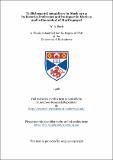Files in this item
Τὸ βδἐλυγμα tὴζ ἐρημὡδ εωv in Mark 13:14; its historical reference and its impact in Mark 13 and in the context of Mark's gospel
Item metadata
| dc.contributor.author | Such, W. A. | |
| dc.coverage.spatial | 277 p. | en_US |
| dc.date.accessioned | 2018-06-18T08:50:54Z | |
| dc.date.available | 2018-06-18T08:50:54Z | |
| dc.date.issued | 1998-03 | |
| dc.identifier.uri | https://hdl.handle.net/10023/14149 | |
| dc.description.abstract | In spite of the wealth of material on Mark 13:14 the phrase [greek characters] has not been syntactically exegeted sufficiently in respect to chapter 13, nor its place assessed in the formation of Mark's gospel. Our study demonstrates the fundamental significance of v.14 as the syntactical focal point of vv.5-13, that content, temporal indicators and link words are shaped syntactically in w.5-13 to peak at v.14, and that [greek characters] is uniquely to of v.4. A realization of this connection is the single indispensable clue unlocking eschatological notions in chapter 13. Further, by positing that v.14, coupled with v.26-27, produces a double focus in the chapter, we demonstrate its importance for vv.15-37. The advent of [greek characters] is the sign launching the end-time setting in motion an imminent parousia. This sign is connected with the Jerusalem temple's destruction by the Roman commander Titus in September 70 C.E. Titus is the referent in 13:14, though our contention is that originally in pre-Markan material in v.l4, the reference was to the crisis in 39-41 C.E. when the emperor Gaius Caligula attempted to erect an image of himself in the temple in Jerusalem. Mark obtained material from this episode and adapted it to indicate not the deified image of a Roman emperor but an individual abominator, Titus, who was [greek characters]. An examination of Josephus' War demonstrates that Judeans inhabiting the region after September 70 C.E. were in a position to flee according to 13:14b. Mark's Jewish Gentile community, located in Syria or one of the Transjordanian Hellenistic cities, must brace itself for a worsening period of turmoil in the light of the operational end-time sign in the temple in Jerusalem. The task of the community is to proclaim the gospel among the nations (13:10). Their final vindication will occur with the parousia of the Son of Man. | en_US |
| dc.language.iso | en | en_US |
| dc.publisher | University of St Andrews | |
| dc.subject.lcc | BS2585.2S9 | en |
| dc.subject.lcsh | Bible. Mark, XIII--Criticism, interpretation, etc | en |
| dc.title | Τὸ βδἐλυγμα tὴζ ἐρημὡδ εωv in Mark 13:14; its historical reference and its impact in Mark 13 and in the context of Mark's gospel | en_US |
| dc.type | Thesis | en_US |
| dc.type.qualificationlevel | Doctoral | en_US |
| dc.type.qualificationname | PhD Doctor of Philosophy | en_US |
| dc.publisher.institution | The University of St Andrews | en_US |
This item appears in the following Collection(s)
Items in the St Andrews Research Repository are protected by copyright, with all rights reserved, unless otherwise indicated.

